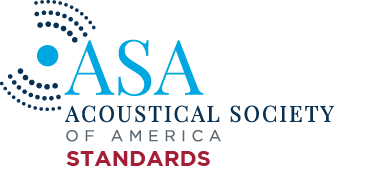We’re delighted to announce this set of newly reaffirmed (2024) ASA Standards:
ASA STANDARDS S1 COMMITTEE:
ASA/ANSI S1.4-2014/Part 1/IEC 61672-1-2013 (R2024)
Electroacoustics – Sound Level Meters – Part 1: Specifications
Abstract:
This part of ANSI/ASA S1.4 / IEC 61672 gives electroacoustical performance specifications for three kinds of sound-measuring instruments: a time-weighting sound level meter that measures exponential time-weighted, frequency-weighted sound levels; an integrating-averaging sound level meter that measures time-averaged, frequency-weighted sound levels; and an integrating sound level meter that
measures frequency-weighted sound exposure levels.
ASA/ANSI S1.4-2014/Part 2/IEC 61672-2-2013 (R2024)
Electroacoustics – Sound Level Meters – Part 2: Pattern Evaluation Tests
Abstract:
ANSI/ASA S1.4-2014/Part 2 / IEC 61672-2:2013 provides details of the tests necessary to verify conformance to all mandatory specifications given in ANSI/ASA S1.4-2014/Part 1 / IEC 61672-1:2013 for time-weighting sound level meters, integrating-averaging sound level meters, and integrating sound level meters. Pattern-evaluation tests apply for each channel of a multi-channel sound level meter, as necessary. Tests and test methods are applicable to class 1 and class 2 sound level meters. The aim is to ensure that all laboratories use consistent methods to perform pattern-evaluation tests. This edition constitutes a technical revision; the main technical changes with regard to the previous edition concern conformance to specifications which is now demonstrated when measured deviations from design goals do not exceed the applicable acceptance limits, and when the uncertainty of measurement does not exceed the corresponding maximum permitted uncertainty, with both uncertainties determined for a coverage probability of 95 %. In this document, references to IEC 61672-1, IEC 61672-2, and IEC 61672-3 refer to the second editions of the IEC standards unless stated otherwise. They refer equally to the ANSI/ASA S1.4-2014 / IEC 61672:2013 editions. Procedures for the pattern-evaluation testing of sound level meters designed to conform to the specifications of IEC 61672-1:2002 were given in IEC 61672-2:2003.
ASA/ANSI S1.4-2014/Part 2 Amd.1-2019/IEC 61672-2:2013 Amd.1:2017 (R2024)
Electroacoustics – Sound Level Meters – Part 2: Pattern Evaluation Tests – Amendment 1
Abstract:
This document is an amendment to ANSI/ASA S1.4-2014/Part 2/IEC 61672-2:2013. The committee has decided that the contents of this amendment and the base publication will remain unchanged until the IEC stability date indicated on the IEC website in the data related to this publication. Since these documents are identical national adoptions, ASA will follow the same process.
ASA/ANSI S1.4-2014/Part 3/IEC 61672-3:2013 (R2024)
Electroacoustics – Sound Level Meters – Part 3: Periodic Tests
Abstract:
ANSI/ASA S1.4-2014/Part 3 / IEC 61672-3:2013 describes procedures for periodic testing of timeweighting, integrating-averaging, and integrating sound level meters that were designed to conform to the class 1 or class 2 specifications of ANSI/ASA S1.4-2014/Part 1 / IEC 61672-1. The aim of the standard is to ensure that periodic testing is performed in a consistent manner by all laboratories. The purpose of periodic testing is to assure the user that the performance of a sound level meter conforms to the applicable specifications of ANSI/ASA S1.4-2014/Part 1 / IEC 61672-1 for a limited set of key tests and for the environmental conditions under which the tests were performed. Periodic tests described in this edition of ANSI/ASA S1.4-2014/Part 3 / IEC 61672-3 apply to sound level meters for which the manufacturer claims conformance to the specifications of the second edition of ANSI/ASA S1.4-2014/ Part 1 / IEC 61672-1. Periodic tests described in ANSI/ASA S1.4-2014/Part 3 / IEC 61672-3 apply to sound level meters for which the model has been, or has not been, pattern approved by an independent testing organization responsible for pattern approvals in accordance with the test procedures of ANSI/ASA S1.4-2014/Part 2 / IEC 61672-2. Procedures for the periodic testing of sound level meters designed to conform to the specifications of IEC 61672-1:2002 were given in IEC 61672-3:2006.
ASA STANDARDS S2 COMMITTEE:
ASA/ANSI S2.62-2009 (R2024)
Shock Test Requirements for Equipment in a Rugged Shock Environment
Abstract:
This American National Standard is to be used for testing equipment that will be subjected to shock. It defines test requirements and severity thresholds for a large range of shock environments, including but not limited to shipping, transport, and rugged operational environments. This standard will allow vendors to better market and users to more easily identify equipment that will operate or simply survive in rugged shock environments.
ASA/ANSI S2.73-2014/ISO 10819:2013 (R2024)
Mechanical Vibration and Shock – Hand-arm Vibration – Measurement and evaluation of the vibration transmissibility of gloves at the palm of the hand
Abstract:
This American National Standard specifies a method for the laboratory measurement, data analysis, and reporting of the vibration transmissibility of a glove with a vibration-reducing material that covers the palm, fingers, and thumb of the hand. ANSI/ASA S2.73-2014 / ISO 10819:2013 specifies vibration transmissibility in terms of vibration transmitted from a handle through a glove to the palm of the hand in hrough a glove to the palm of the hand in one-third-octave frequency bands with center frequencies of 25 Hz to 1,250 Hz.
ANSI/ASA S2.73 Amd.1-2019/ISO 10819 Amd.1-2019 (R2024)
Mechanical Vibration and Shock – Hand-arm Vibration – Measurement and Evaluation of the Vibration Transmissibility of Gloves at the Palm of the Hand, Amendment 1
Abstract:
This document is an amendment to ANSI/ASA S2.73-2014/ISO 10819:2013 (R2019). The committee has decided that the contents of this amendment and the base publication will remain unchanged until the ISO stability date indicated on the ISO website in the data related to this publication. Since these documents are identical national adoptions, ASA will follow the same process.

0 Comments